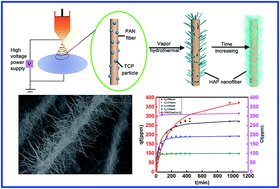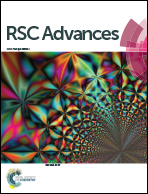Hydrothermal-assisted biomimetic synthesis of a brush-like Hap/PAN composite and its application for decontaminating metal ions†
Abstract
In this work, a novel biomimetic mat consisting of brush-like polyacrylonitrile (PAN)–hydroxyapatite (Hap) composite fibers was successfully prepared by means of a combination of two simple but effective methods – electrospinning technology and vapor hydrothermal treatment. The backbone of the fiber is the PAN fiber with a diameter of 2–3 μm and the lateral branch is the Hap nanowires. In the biomimetic process, calcium phosphate (TCP) worked as the seed and it transferred to the Hap nanowire in situ and pierced the PAN fiber when it was cultured under a high temperature vapor. This mat is an ideal candidate material for decontaminating metal ions in terms of its convenience of recycling and high specific surface area. The as-obtained materials were characterized with X-ray diffractometry (XRD), transmission electron microscopy (TEM) and scanning electron microscopy (SEM). Moreover, adsorption experiments of the PAN/Hap composite fiber mat for Pb2+ were conducted. The results exhibited that the maximum adsorption quantity of the composite fiber mat for heavy metal Pb2+ was up to 433 mg g−1, and the Pb2+ adsorption process occurs through a two-step mechanism: rapid surface complexation followed by partial dissolution of hydroxyapatite and precipitation of pyromorphite.


 Please wait while we load your content...
Please wait while we load your content...